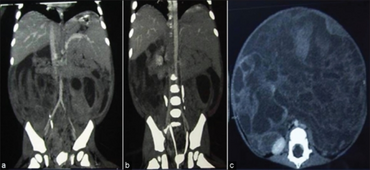Sarcoma botryoides
| Sarcoma botryoides | |
|---|---|
| Other names: Botryoid rhabdomyosarcoma | |
 | |
| a-c)Contrast-enhanced computed tomography of abdomen | |
| Specialty | Oncology |
Sarcoma botryoides or botryoid sarcoma[1] is a subtype of embryonal rhabdomyosarcoma, that can be observed in the walls of hollow, mucosa lined structures such as the nasopharynx, common bile duct, urinary bladder of infants and young children or the vagina in females, typically younger than age 8. The name comes from the gross appearance of "grape bunches" (botryoid in Greek).
Signs and symptoms
For botryoid rhabdomyosarcoma of the vagina, the most common clinical finding is vaginal bleeding[2] but vaginal bleeding is not specific for sarcoma botryoides: other vaginal cancers are possible. They may appear as a polypoid mass, somewhat yellow in color and are friable: thus, they (possibly) may break off, leading to vaginal bleeding or infections.[citation needed]
Histology
Under the microscope one can see rhabdomyoblasts that may contain cross-striations. Tumor cells are crowded in a distinct layer beneath the vaginal epithelium (cambium layer). Spindle-shaped tumor cells that are desmin positive.[citation needed]
Diagnosis
Differential diagnosis
The DDx for Sarcoma botryoides is as follows:[3]
- Fibroepithelial polyp
- Mullerian papilloma
- Rhabdomyoma
Treatment
The disease used to be uniformly fatal, with a 5-year survival rate between 10 and 35%.[4] As a result, treatment was radical surgery. New multidrug chemotherapy regimens with or without radiation therapy are now used in combination with less radical surgery with good results, although outcome data are not yet available.[5]
Epidemiology
Sarcoma botryoides normally is found in children under 8 years of age. Onset of symptoms occurs at age 3 years (38.3 months) on average.[6] Cases of older women with this condition have also been reported.[7]
References
- ↑ "botryoid sarcoma" at Dorland's Medical Dictionary
- ↑ Rahaman, J and Cohen, CJ. Gynecologic Sarcomas. in Holland-Frei Cancer Medicine - 6th Ed. Kufe, DW et al. editors. BC Decker Inc., Hamilton, Ontario, 2003.
- ↑ Wu, Maoxin; Deligdisch, Liane; Llorca, Frederique Penault; Schlosshauer, Peter W.; Altchek, Albert (22 December 2008). Early Pathologic Diagnosis Of Gynecologic Cancer Including A Clinician's View. World Scientific Publishing Company. p. 99. ISBN 978-981-310-727-4. Archived from the original on 17 October 2022. Retrieved 15 October 2022.
- ↑ Piver M, Rose P (1988). "Long-term follow-up and complications of infants with vulvovaginal embryonal rhabdomyosarcoma treated with surgery, radiation therapy, and chemotherapy". Obstet Gynecol. 71 (3 Pt 2): 435–7. PMID 3347430.
- ↑ Rotmensch, J and Yamada, SD. Neoplasms of the Vulva and Vagina. in Holland-Frei Cancer Medicine - 6th Ed. Kufe, DW et al. editors. BC Decker Inc., Hamilton, Ontario, 2003.
- ↑ Hilgers R (1975). "Pelvic exenteration for vaginal embryonal rhabdomyosarcoma: a review". Obstet Gynecol. 45 (2): 175–80. PMID 1090863.
- ↑ Reynolds E, Logani S, Moller K, Horowitz I (2006). "Embryonal rhabdomyosarcoma of the uterus in a postmenopausal woman. Case report and review of the literature". Gynecol Oncol. 103 (2): 736–9. doi:10.1016/j.ygyno.2006.03.033. PMID 16684558.
External links
- humpath.com #12369 Archived 2021-07-29 at the Wayback Machine
| Classification |
|---|